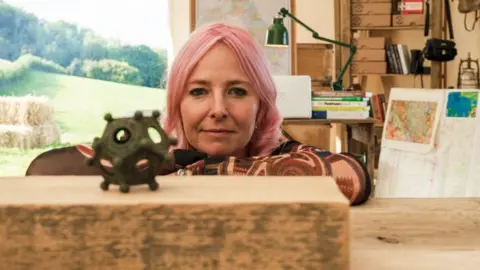20 hours ago
By David McKenna & Gemma Dawson,BBC News
Share

Norton Disney History and Archaeology Group
The 12-sided object, which has baffled experts as to its use, is the first to be discovered in the Midlands
A mysterious Roman artefact dug up in Lincolnshire has left experts baffled as to what it is. Found during an amateur archaeological dig in Norton Disney - where Walt Disney's ancestors hailed from - the 12-sided object has prompted fantastical suggestions as to its use.
It has been likened to a dog treat dispenser, a spaghetti measure and even a measuring gauge for slingshot.
Here, architectural historian and broadcaster Dr Jonathan Foyle offers his take on some of the suggestions put forward by BBC website users, and his own theory as to the object's purpose.

Toy story
David Hawley thought it was probably some sort of game dice, with the different sized holes denoting a different number.
"There are other sizes of dodecahedron in existence which could be more portable to carry if the army was on the move," Dr Foyle countered.
Lee Hartfield suggested it was some form of puzzle where the player had to align the right-sized ball with the correct hole.
In response, Dr Foyle said: "What's really striking about them is they are beautifully crafted and none of them show any signs of wear.
"They don't have any numbers on them so you can roll them [as dice]," he said.
He said although the artefact resembled a puzzle you might find in a Christmas cracker, the metal was "quite fragile" and would break.
"These things were clearly looked after," he added.
A mysterious Roman artefact dug up in Lincolnshire has left experts baffled as to what it is. Found during an amateur archaeological dig in Norton Disney - where Walt Disney's ancestors hailed from - the 12-sided object has prompted fantastical suggestions as to its use.
It has been likened to a dog treat dispenser, a spaghetti measure and even a measuring gauge for slingshot.
Here, architectural historian and broadcaster Dr Jonathan Foyle offers his take on some of the suggestions put forward by BBC website users, and his own theory as to the object's purpose.

Toy story
David Hawley thought it was probably some sort of game dice, with the different sized holes denoting a different number.
"There are other sizes of dodecahedron in existence which could be more portable to carry if the army was on the move," Dr Foyle countered.
Lee Hartfield suggested it was some form of puzzle where the player had to align the right-sized ball with the correct hole.
In response, Dr Foyle said: "What's really striking about them is they are beautifully crafted and none of them show any signs of wear.
"They don't have any numbers on them so you can roll them [as dice]," he said.
He said although the artefact resembled a puzzle you might find in a Christmas cracker, the metal was "quite fragile" and would break.
"These things were clearly looked after," he added.
'Romans loved spaghetti'
Others thought the dodecahedron might have been used as a measuring device.
Brian Turner, from Norfolk, suggested it was a gauge for measuring lead balls or slingshot.
Meanwhile, Paul Roberts, from Dorset said it was "obviously a spaghetti measure".
"The Romans loved spaghetti, but obviously it was just as difficult back then as it is nowadays to work out exactly how much spaghetti to cook.
"I have a modern version of this, it's a lot more convenient but probably not as valuable," he added.

Jonathan Foyle
Dr Jonathan Foyle, who grew up in Lincolnshire, said he was delighted this dodecahedron had been unearthed in his home county
Dr Foyle replied that the Roman conquest of Britain would have "gone much more smoothly" with "bowls of carbonara" being dished out, but the foodstuff didn't become a staple in Italy until well after the fall of the Roman Empire.
"While the Romans had to wait centuries for pasta, they chowed down on dormice in fish sauce," he said.
Other suggestions included a fishing weight or a device used in childbirth to measure cervical dilation.
Nigel Monk thought it could be some sort of teaching device used by Roman mathematicians.
"Also it may just have been an ornament," he added.
Michael Lynch said it looked like an incense burner to get rid of smells - "an early version of a modern-day Air Wick".
Ruth Gilbert put forward the idea of a "rollable" pet treat dispenser.
"There are modern dog treat dispensers that look a lot like it - it must be said," Dr Foyle conceded.
"I've seen modern rubber ones. So if that's true, they should have asserted copyright."
Dr Foyle replied that the Roman conquest of Britain would have "gone much more smoothly" with "bowls of carbonara" being dished out, but the foodstuff didn't become a staple in Italy until well after the fall of the Roman Empire.
"While the Romans had to wait centuries for pasta, they chowed down on dormice in fish sauce," he said.
Other suggestions included a fishing weight or a device used in childbirth to measure cervical dilation.
Nigel Monk thought it could be some sort of teaching device used by Roman mathematicians.
"Also it may just have been an ornament," he added.
Michael Lynch said it looked like an incense burner to get rid of smells - "an early version of a modern-day Air Wick".
Ruth Gilbert put forward the idea of a "rollable" pet treat dispenser.
"There are modern dog treat dispensers that look a lot like it - it must be said," Dr Foyle conceded.
"I've seen modern rubber ones. So if that's true, they should have asserted copyright."

BBC/Rare TVDigging for Britain's Alice Roberts described the Norton Disney find as one of the most remarkable things she had ever seen
The Norton Disney artefact featured in a recent episode of Digging for Britain, with presenter Prof Alice Roberts saying: "It has to be one of the greatest, most mysterious, archaeological objects I've ever had the opportunity to look at up close."
Commenting on the level of interest in the Norton Disney artefact, she added: "There are so many mysteries in archaeology that remain to be solved.
"The overwhelming range of responses to it from the audience shows just how these ancient riddles can capture the public imagination."
Newcastle student Lorena Hitchens, who goes by the name of Dodecahedra Girl on X (formerly Twitter), also featured in the show.
Ms Hitchens, who is studying the puzzling objects for her PhD, said: "For me, the challenge of solving the puzzle of what these items are is part of their appeal."
All fingers and thumbs
James Wyman supported the popular theory that it was a device used for knitting, while Lauren Dolphin, from Essex, said: "It is for crocheting gloves, different holes for different finger/thumb sizes."
"Perhaps they need more women on the dig team, lol."
Dr Foyle, who has appeared on TV shows including Time Team and Meet the Ancestors, replied: "I bet Alice Roberts would be absolutely up for that suggestion."
Some creative types have also taken it one step further and produced YouTube crafting tutorials using a plastic model of a dodecahedron.
"You can indeed make a glove finger from them, which people have ingeniously done," Dr Foyle said.
However, for the Romans "there was no evidence of knitting until centuries afterwards", he added.
One person suggested it was for sizing eggs.
Dr Foyle said he wasn't convinced there was any need to grade eggs at that time and "didn't think that idea's going to make it".

The Norton Disney artefact featured in a recent episode of Digging for Britain, with presenter Prof Alice Roberts saying: "It has to be one of the greatest, most mysterious, archaeological objects I've ever had the opportunity to look at up close."
Commenting on the level of interest in the Norton Disney artefact, she added: "There are so many mysteries in archaeology that remain to be solved.
"The overwhelming range of responses to it from the audience shows just how these ancient riddles can capture the public imagination."
Newcastle student Lorena Hitchens, who goes by the name of Dodecahedra Girl on X (formerly Twitter), also featured in the show.
Ms Hitchens, who is studying the puzzling objects for her PhD, said: "For me, the challenge of solving the puzzle of what these items are is part of their appeal."
All fingers and thumbs
James Wyman supported the popular theory that it was a device used for knitting, while Lauren Dolphin, from Essex, said: "It is for crocheting gloves, different holes for different finger/thumb sizes."
"Perhaps they need more women on the dig team, lol."
Dr Foyle, who has appeared on TV shows including Time Team and Meet the Ancestors, replied: "I bet Alice Roberts would be absolutely up for that suggestion."
Some creative types have also taken it one step further and produced YouTube crafting tutorials using a plastic model of a dodecahedron.
"You can indeed make a glove finger from them, which people have ingeniously done," Dr Foyle said.
However, for the Romans "there was no evidence of knitting until centuries afterwards", he added.
One person suggested it was for sizing eggs.
Dr Foyle said he wasn't convinced there was any need to grade eggs at that time and "didn't think that idea's going to make it".

VW Pics/Getty Images
Some suggested a calendar or a device for charting the night sky
Some thought the 12-sided object was some type of desk calendar, or astronomical device.
Paula Dhugga put forward the idea that the 12 faces represented the 12 months, with the different face designs representing the differences between the months, or possibly seasons.
Steve Hill suggested a similar idea with the different sized holes denoting a different month and straws being added or removed to show the date.
"Because you have the smallest hole for December and the largest one for June, you can know when the shortest and longest days are," he said.
"Much more convenient than lugging Stonehenge around with you."
Others suggested some sort of of surveying device, while Chess Man thought it could be "a very crude and primitive sort of astronomical device".
"A primitive means of charting the night sky. Drawing the star patterns (constellations) down in an effort to measure and chart those. Using the holes to peer through so as to measure certain regions of the night sky," he said.
'Not Roman'
The object is one of only 33 dodecahedrons found in Britain, and the first to have been discovered in the Midlands.
So what does Dr Foyle think it was used for and does he concur with any of the suggestions listed above?
"What I think it is is a device for framing the constellations of the zodiac," Dr Foyle said (star of the day for Chess Man).
"If you look through them you can frame a view - much like a camera operator," he said.
Some thought the 12-sided object was some type of desk calendar, or astronomical device.
Paula Dhugga put forward the idea that the 12 faces represented the 12 months, with the different face designs representing the differences between the months, or possibly seasons.
Steve Hill suggested a similar idea with the different sized holes denoting a different month and straws being added or removed to show the date.
"Because you have the smallest hole for December and the largest one for June, you can know when the shortest and longest days are," he said.
"Much more convenient than lugging Stonehenge around with you."
Others suggested some sort of of surveying device, while Chess Man thought it could be "a very crude and primitive sort of astronomical device".
"A primitive means of charting the night sky. Drawing the star patterns (constellations) down in an effort to measure and chart those. Using the holes to peer through so as to measure certain regions of the night sky," he said.
'Not Roman'
The object is one of only 33 dodecahedrons found in Britain, and the first to have been discovered in the Midlands.
So what does Dr Foyle think it was used for and does he concur with any of the suggestions listed above?
"What I think it is is a device for framing the constellations of the zodiac," Dr Foyle said (star of the day for Chess Man).
"If you look through them you can frame a view - much like a camera operator," he said.

sololos/Getty Images
Dr Foyle believes it was used for framing the constellations of the zodiac
Explaining his theory, the broadcaster said the Romans had brought with them an understanding of the 12-sided universe that Plato described.
However, he believes the mysterious objects were made by "a wonderful culture of metal-crafting by people we call the Celts."
"You don't find them in the Mediterranean at the core of the Roman empire, and you don't find them in the unconquered Celtic lands.
"I think the Romans influenced the native metal-crafters."
A dodecahedron found in Switzerland in 1982 also listed the names of the zodiac on each of the faces, Dr Foyle said.
"That's what makes me think that's what it is."Hear more from Dr Jonathan Foyle on BBC Sounds
The mysterious objects date back as far as the 1st Century. Some experts believe they were possibly linked to Roman rituals or religion, but there are no references to them in any Roman texts.
Richard Parker, secretary of the Norton Disney History and Archaeology Group, said the group planned to return to the dig site later this year in the hope of unearthing more clues.
In the meantime, history sleuths will be able to see the object on display at Lincoln Museum until September.
Explaining his theory, the broadcaster said the Romans had brought with them an understanding of the 12-sided universe that Plato described.
However, he believes the mysterious objects were made by "a wonderful culture of metal-crafting by people we call the Celts."
"You don't find them in the Mediterranean at the core of the Roman empire, and you don't find them in the unconquered Celtic lands.
"I think the Romans influenced the native metal-crafters."
A dodecahedron found in Switzerland in 1982 also listed the names of the zodiac on each of the faces, Dr Foyle said.
"That's what makes me think that's what it is."Hear more from Dr Jonathan Foyle on BBC Sounds
The mysterious objects date back as far as the 1st Century. Some experts believe they were possibly linked to Roman rituals or religion, but there are no references to them in any Roman texts.
Richard Parker, secretary of the Norton Disney History and Archaeology Group, said the group planned to return to the dig site later this year in the hope of unearthing more clues.
In the meantime, history sleuths will be able to see the object on display at Lincoln Museum until September.
No comments:
Post a Comment